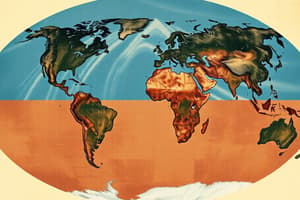Podcast
Questions and Answers
What did Alfred Wegener propose about the continents?
What did Alfred Wegener propose about the continents?
- They are fixed in place.
- They are connected by underwater tunnels.
- They are getting larger.
- They are moving. (correct)
Alfred Wegener was a prominent geologist.
Alfred Wegener was a prominent geologist.
False (B)
What did Wegener notice about the continents that inspired his theory?
What did Wegener notice about the continents that inspired his theory?
They looked like puzzle pieces that fit together.
Alfred Wegener lived during the late 1800s and early _____ centuries.
Alfred Wegener lived during the late 1800s and early _____ centuries.
Match the following continents with their sides they supposedly fit together:
Match the following continents with their sides they supposedly fit together:
What is the name of the supercontinent that Vagner proposed existed about 250 million years ago?
What is the name of the supercontinent that Vagner proposed existed about 250 million years ago?
Vagner's theory about continental drift was widely accepted at first.
Vagner's theory about continental drift was widely accepted at first.
What did Vagner observe about the continents that led him to believe they were once connected?
What did Vagner observe about the continents that led him to believe they were once connected?
The Meza soros was an ancient reptile that lived only in _____ freshwater.
The Meza soros was an ancient reptile that lived only in _____ freshwater.
Match the types of evidence Vagner used to support his theory with their descriptions:
Match the types of evidence Vagner used to support his theory with their descriptions:
Which ancient reptile's fossils were found on both the eastern coast of South America and the western coast of Africa?
Which ancient reptile's fossils were found on both the eastern coast of South America and the western coast of Africa?
What was the significance of the matching mountain ranges in Vagner's evidence?
What was the significance of the matching mountain ranges in Vagner's evidence?
Fossil correlation provides evidence that continents were never connected.
Fossil correlation provides evidence that continents were never connected.
Vagner's hypothesis was initially regarded as _____ by many people.
Vagner's hypothesis was initially regarded as _____ by many people.
What does the term 'fossil correlation' refer to in Vagner's evidence?
What does the term 'fossil correlation' refer to in Vagner's evidence?
Flashcards
Continental Drift Theory
Continental Drift Theory
The idea that continents were once joined and have moved apart over time.
Alfred Wegener
Alfred Wegener
A German meteorologist who proposed the continental drift theory.
Continents
Continents
Large landmasses on Earth.
Puzzle pieces
Puzzle pieces
Signup and view all the flashcards
Moving Continents
Moving Continents
Signup and view all the flashcards
Pangaea
Pangaea
Signup and view all the flashcards
Continental Drift
Continental Drift
Signup and view all the flashcards
Fossil Correlation
Fossil Correlation
Signup and view all the flashcards
Apparent Fit of Continents
Apparent Fit of Continents
Signup and view all the flashcards
Mesosaurus
Mesosaurus
Signup and view all the flashcards
Rock Correlation
Rock Correlation
Signup and view all the flashcards
Evidence for Continental Drift
Evidence for Continental Drift
Signup and view all the flashcards
Matching Fossils
Matching Fossils
Signup and view all the flashcards
Mountain Correlation
Mountain Correlation
Signup and view all the flashcards
Study Notes
Continental Drift Theory
- Alfred Wegener, a German meteorologist, proposed the theory of continental drift.
- He noticed continents seemed to fit together like puzzle pieces, particularly the eastern coast of South America and the western coast of Africa.
- This observation, though known for centuries, was considered by Wegener as a significant clue.
- Wegener's theory suggested continents were once connected and have since drifted apart.
- He named the supercontinent Pangaea, which existed approximately 250 million years ago.
- Pangaea is a Greek term meaning "entire earth" or "all earth."
- Wegener's model showed modern continents joined as Pangaea.
Evidence for Continental Drift
- Apparent Fit of Continents: Continents seemingly fit together like puzzle pieces, suggesting a prior connection.
- Fossil Correlation: Identical fossils of the freshwater reptile Mesosaurus have been found in both South America and Africa. Other fossils exhibit similar patterns, aligning with continents once being together.
- Rock/Mountain Correlation: Similar rock types and mountain ranges in the northeastern US and Northern Europe. The evidence suggests these were linked and separated when continents drifted apart.
- Paleo-Climate Data: Glacial striations, evidence of ancient glaciers, have been found in tropical regions of South America and Africa, implying a shift in their positions and past climates that were once in polar areas. Bituminous coal (formed from compressed tropical plants) is found in locations that are now in cold environments, further supporting the idea of continental relocation.
Wegener's Contributions & Fate
- Wegener presented his theory in a book The Origin of Continents and Oceans.
- He proposed that Pangaea fragmented and the continents moved to their current locations.
- Despite his evidence, Wegener's theory was initially met with skepticism, lacking a mechanism for continental movement.
- Wegener died before his work was widely accepted. His expedition to the North Pole resulted in his death from exposure.
Studying That Suits You
Use AI to generate personalized quizzes and flashcards to suit your learning preferences.




